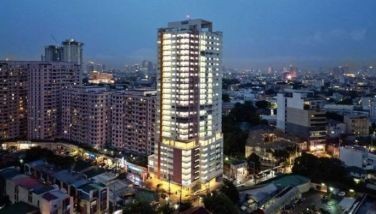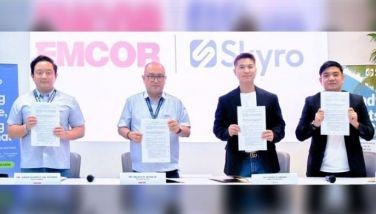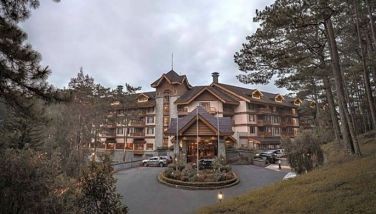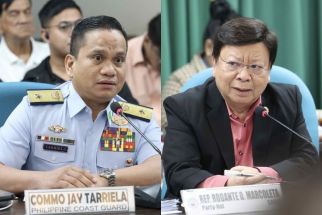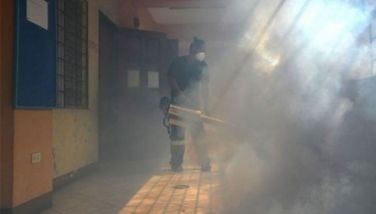‘80% chance of recovery for FG’
April 13, 2007 | 12:00am
(The author is the main attending physician of First Gentleman Jose Miguel Arroyo. She is a regular contributor to The STAR’s science and health page.)
First Gentleman Jose Miguel Arroyo remains in stable but guarded condition two days after undergoing open-heart surgery to repair a tear in his aorta, even as his medical team at St. Luke’s Medical Center is doing its best to restore the function of Mr. Arroyo’s vital organs. The critical 48-hour period has now passed without any untoward developments but the First Gentleman must remain under intensive care for five to seven days more. He now has about an 80 percent chance of recovering without any complications.
The First Gentleman underwent a very high-risk operation, and we are keeping a tight watch for any signs of possible complications in his lungs, kidneys, liver, pancreas, brain and heart. At present, we have stabilized his condition but we have to continue supporting the function of his lungs and kidneys through ventilator support and dialysis, respectively, to help them cope with the load of fluids and blood products administered to him during the surgery.
The 10-hour operation required the significant lowering of the First Gentleman’s body temperature (15°C) to prevent organ damage and the temporary stoppage of the blood circulation to his entire body to make the aneurysmectomy at the level of the arch of the aorta possibleâ€â€Ânecessary steps that may compromise the function of vital organs, especially the brain.
Nevertheless, the medical condition of the First Gentleman remains stable and his medical team is guardedly optimistic about the outcome of Mr. Arroyo’s surgery.
The First Gentleman was admitted at the St. Louis University’s Hospital of the Sacred Heart in Baguio City on April 8, Easter Sunday, after complaining of abdominal and back pain. Finding Mr. Arroyo’s heart to be stable, doctors diagnosed him as suffering from chronic gastritis and he was discharged the next day. Doctors at the hospital advised the First Gentleman to undergo further tests at St. Luke’s Medical Center in Quezon City.
On the afternoon of April 9, Mr. Arroyo was admitted at St. Luke’s Medical Center where we diagnosed him as suffering from thoracic aortic aneurysm with acute aortic arch dissection. Aortic dissection especially at the arch is an uncommon but potentially fatal illness caused by a tear in the innermost layer of the aorta, the major artery that carries blood from the heart to the rest of the body. Roughly the diameter of a garden hose, the aorta extends from the heart down through the chest and abdominal region, where it divides into a blood vessel that supplies each leg.
"Any condition that weakens the layers of the aortic wall puts an individual at risk for aortic dissection. Advanced age, atherosclerosis (hardening of the arteries due to fatty deposits), and hypertension are the most important risk factors," according to St. Luke’s Heart Institute Director Dr. Antonio Sibulo Jr.
Peak incidence of aortic dissection is between the ages of 60 and 70 years, with men affected twice as often as women. The most common complaint is chest or abdominal pain described as tearing, sharp, or stabbing. The pain may be felt at the front or back or may move as the dissection (tear) extends. Acute aortic dissection is an emergency requiring immediate medical treatment, Sibulo explained.
"Aortic dissection may affect any part of the aorta but the majority of cases involve the segment at the ascending aorta followed by the descending aorta," according to Dr. Rommel Cariño, the thoracic and cardiovascular surgeon who performed the operation on the First Gentleman.
The rarest, most difficult form to manage is the one that develops at the level of the aortic arch, type 1, the type suffered by Mr. Arroyo, Cariño explained. "It can compromise blood supply to vital organs such as the brain, gastrointestinal tract, kidneys, etc. Acute aortic arch dissection has a high mortality rate."
According to Cariño, the tear in Mr. Arroyo’s aorta was "very extensive," extending from the root of the aorta near the heart to the level of the groin. The tear diverted blood flow from the inner cavity of the aorta to the "false cavity" caused by the tear. As a result, the false cavity ballooned and compressed the blood vessels supplying the First Gentleman’s vital organs such as his intestines, heart, and right kidney. The compression of these vessels manifested in Mr. Arroyo as abdominal pain and severe back pain, Cariño explained.
The life-saving aneurysmectomy Cariño and his surgical team performed on the First Gentleman involved replacing the ascending aorta and aortic arch with an artificial graft sewn in place with a permanent suture. After repairing the aortic dissection, Cariño performed triple coronary artery bypass surgery on Mr. Arroyo.
"In the course of the aneurysmectomy, we discovered that three major arteries of the First Gentleman’s heart were blocked, so we had to put grafts in those obstructed arteries to prevent a heart attack and improve Mr. Arroyo’s heart function as well," Cariño said.
The need for a high index of suspicion complemented by state-of-the-art diagnostic imaging equipment available at SLMC enabled the medical team to establish a definitive diagnosis of the First Gentleman’s condition and the surgical team to perform the emergency operation.
Close monitoring and support of all the First Gentleman’s vital organs are very important. The different specialists in Mr. Arroyo’s medical team are doing their best to maintain and improve the functions of his vital organs.
"The First Gentleman must adhere strictly to a healthy lifestyle, go for regular medical check-ups, and undergo cardiac rehabilitation as soon as he recovers from his operation," Sibulo stressed.
Aneurysms, particularly aortic dissection, are usually diagnosed too late. Dr. Cesar Recto II, president of the Philippine Heart Association and a cardiologist at St. Luke’s Medical Center, described aortic dissection as a "very difficult case."
"Cardiovascular disease is the leading cause of death in the Philippines and it can hit anyone at anytime without warning," Recto said. "It can mimic the symptoms of other illnesses like gastrointestinal diseases or can remain asymptomatic and be even more treacherous. The best remedy for cardiovascular disease is still prevention."
Dr. Alex Yap, the Filipino cardiovascular surgeon who arrived from California as a guest doctor of the First Family, commended the excellence of the SLMC medical and surgical teams that treated the First Gentleman. "They have done an excellent job, and there is really no need for my assistance in managing Mr. Arroyo’s condition. In fact, the First Gentleman is recovering faster compared to most patients I have seen that have a similar condition."
We salute the expertise and dedication of the First Gentleman’s multidisciplinary medical and surgical teams: Dr. Joven Cuanang (neurologist and St. Luke’s medical director), Dr. Rommel Cariño (cardiovascular surgeon), Dr. Antonio Sibulo Jr. (director, St. Luke’s Heart Institute), Dr. Romeo Saavedra (cardiologist), Dr. Jose Nicanor Cruz (interventional cardiologist), Dr. Nancy Chio (cardiac intensivist), Dr. Myra Dolor (cardiac intensivist), Dr. Gary Lopez (a relative and personal cardiologist of Mr. Arroyo), Dr. Jonnel Lim (chair, Department of Anesthesiology), Dr. Dahlia Estrera (anesthesiologist), Dr. Ruth Divinagracia (pulmonary intensivist), Dr. Oscar Naidas (nephrologist and chair, Department of Medicine), Dr. Dennis Natino (hematologist), Dr. Michael Villa (endocrinologist), Dr. Adrian Peña (infectious disease specialist), Dr. Manuel Mariano (neurosurgeon and director, International Institute for Neurosciences), Dr. Abdias Aquino (neurologist).
We thank everyone for their prayers and support. Please continue praying for the continued recovery of the First Gentleman. Most importantly, we give thanks to the Divine Physician for hearing the prayers of our entire nation.
First Gentleman Jose Miguel Arroyo remains in stable but guarded condition two days after undergoing open-heart surgery to repair a tear in his aorta, even as his medical team at St. Luke’s Medical Center is doing its best to restore the function of Mr. Arroyo’s vital organs. The critical 48-hour period has now passed without any untoward developments but the First Gentleman must remain under intensive care for five to seven days more. He now has about an 80 percent chance of recovering without any complications.
The First Gentleman underwent a very high-risk operation, and we are keeping a tight watch for any signs of possible complications in his lungs, kidneys, liver, pancreas, brain and heart. At present, we have stabilized his condition but we have to continue supporting the function of his lungs and kidneys through ventilator support and dialysis, respectively, to help them cope with the load of fluids and blood products administered to him during the surgery.
The 10-hour operation required the significant lowering of the First Gentleman’s body temperature (15°C) to prevent organ damage and the temporary stoppage of the blood circulation to his entire body to make the aneurysmectomy at the level of the arch of the aorta possibleâ€â€Ânecessary steps that may compromise the function of vital organs, especially the brain.
Nevertheless, the medical condition of the First Gentleman remains stable and his medical team is guardedly optimistic about the outcome of Mr. Arroyo’s surgery.
The First Gentleman was admitted at the St. Louis University’s Hospital of the Sacred Heart in Baguio City on April 8, Easter Sunday, after complaining of abdominal and back pain. Finding Mr. Arroyo’s heart to be stable, doctors diagnosed him as suffering from chronic gastritis and he was discharged the next day. Doctors at the hospital advised the First Gentleman to undergo further tests at St. Luke’s Medical Center in Quezon City.
On the afternoon of April 9, Mr. Arroyo was admitted at St. Luke’s Medical Center where we diagnosed him as suffering from thoracic aortic aneurysm with acute aortic arch dissection. Aortic dissection especially at the arch is an uncommon but potentially fatal illness caused by a tear in the innermost layer of the aorta, the major artery that carries blood from the heart to the rest of the body. Roughly the diameter of a garden hose, the aorta extends from the heart down through the chest and abdominal region, where it divides into a blood vessel that supplies each leg.
"Any condition that weakens the layers of the aortic wall puts an individual at risk for aortic dissection. Advanced age, atherosclerosis (hardening of the arteries due to fatty deposits), and hypertension are the most important risk factors," according to St. Luke’s Heart Institute Director Dr. Antonio Sibulo Jr.
Peak incidence of aortic dissection is between the ages of 60 and 70 years, with men affected twice as often as women. The most common complaint is chest or abdominal pain described as tearing, sharp, or stabbing. The pain may be felt at the front or back or may move as the dissection (tear) extends. Acute aortic dissection is an emergency requiring immediate medical treatment, Sibulo explained.
"Aortic dissection may affect any part of the aorta but the majority of cases involve the segment at the ascending aorta followed by the descending aorta," according to Dr. Rommel Cariño, the thoracic and cardiovascular surgeon who performed the operation on the First Gentleman.
The rarest, most difficult form to manage is the one that develops at the level of the aortic arch, type 1, the type suffered by Mr. Arroyo, Cariño explained. "It can compromise blood supply to vital organs such as the brain, gastrointestinal tract, kidneys, etc. Acute aortic arch dissection has a high mortality rate."
According to Cariño, the tear in Mr. Arroyo’s aorta was "very extensive," extending from the root of the aorta near the heart to the level of the groin. The tear diverted blood flow from the inner cavity of the aorta to the "false cavity" caused by the tear. As a result, the false cavity ballooned and compressed the blood vessels supplying the First Gentleman’s vital organs such as his intestines, heart, and right kidney. The compression of these vessels manifested in Mr. Arroyo as abdominal pain and severe back pain, Cariño explained.
The life-saving aneurysmectomy Cariño and his surgical team performed on the First Gentleman involved replacing the ascending aorta and aortic arch with an artificial graft sewn in place with a permanent suture. After repairing the aortic dissection, Cariño performed triple coronary artery bypass surgery on Mr. Arroyo.
"In the course of the aneurysmectomy, we discovered that three major arteries of the First Gentleman’s heart were blocked, so we had to put grafts in those obstructed arteries to prevent a heart attack and improve Mr. Arroyo’s heart function as well," Cariño said.
The need for a high index of suspicion complemented by state-of-the-art diagnostic imaging equipment available at SLMC enabled the medical team to establish a definitive diagnosis of the First Gentleman’s condition and the surgical team to perform the emergency operation.
Close monitoring and support of all the First Gentleman’s vital organs are very important. The different specialists in Mr. Arroyo’s medical team are doing their best to maintain and improve the functions of his vital organs.
"The First Gentleman must adhere strictly to a healthy lifestyle, go for regular medical check-ups, and undergo cardiac rehabilitation as soon as he recovers from his operation," Sibulo stressed.
Aneurysms, particularly aortic dissection, are usually diagnosed too late. Dr. Cesar Recto II, president of the Philippine Heart Association and a cardiologist at St. Luke’s Medical Center, described aortic dissection as a "very difficult case."
"Cardiovascular disease is the leading cause of death in the Philippines and it can hit anyone at anytime without warning," Recto said. "It can mimic the symptoms of other illnesses like gastrointestinal diseases or can remain asymptomatic and be even more treacherous. The best remedy for cardiovascular disease is still prevention."
Dr. Alex Yap, the Filipino cardiovascular surgeon who arrived from California as a guest doctor of the First Family, commended the excellence of the SLMC medical and surgical teams that treated the First Gentleman. "They have done an excellent job, and there is really no need for my assistance in managing Mr. Arroyo’s condition. In fact, the First Gentleman is recovering faster compared to most patients I have seen that have a similar condition."
We salute the expertise and dedication of the First Gentleman’s multidisciplinary medical and surgical teams: Dr. Joven Cuanang (neurologist and St. Luke’s medical director), Dr. Rommel Cariño (cardiovascular surgeon), Dr. Antonio Sibulo Jr. (director, St. Luke’s Heart Institute), Dr. Romeo Saavedra (cardiologist), Dr. Jose Nicanor Cruz (interventional cardiologist), Dr. Nancy Chio (cardiac intensivist), Dr. Myra Dolor (cardiac intensivist), Dr. Gary Lopez (a relative and personal cardiologist of Mr. Arroyo), Dr. Jonnel Lim (chair, Department of Anesthesiology), Dr. Dahlia Estrera (anesthesiologist), Dr. Ruth Divinagracia (pulmonary intensivist), Dr. Oscar Naidas (nephrologist and chair, Department of Medicine), Dr. Dennis Natino (hematologist), Dr. Michael Villa (endocrinologist), Dr. Adrian Peña (infectious disease specialist), Dr. Manuel Mariano (neurosurgeon and director, International Institute for Neurosciences), Dr. Abdias Aquino (neurologist).
We thank everyone for their prayers and support. Please continue praying for the continued recovery of the First Gentleman. Most importantly, we give thanks to the Divine Physician for hearing the prayers of our entire nation.
BrandSpace Articles
<
>
- Latest
- Trending
Trending
Latest
Trending
Latest
Recommended
February 18, 2025 - 12:00am






